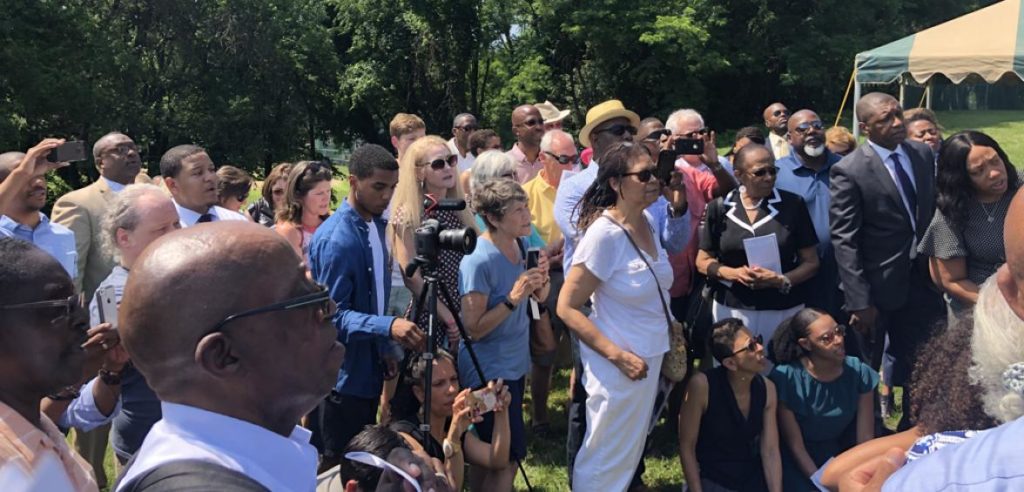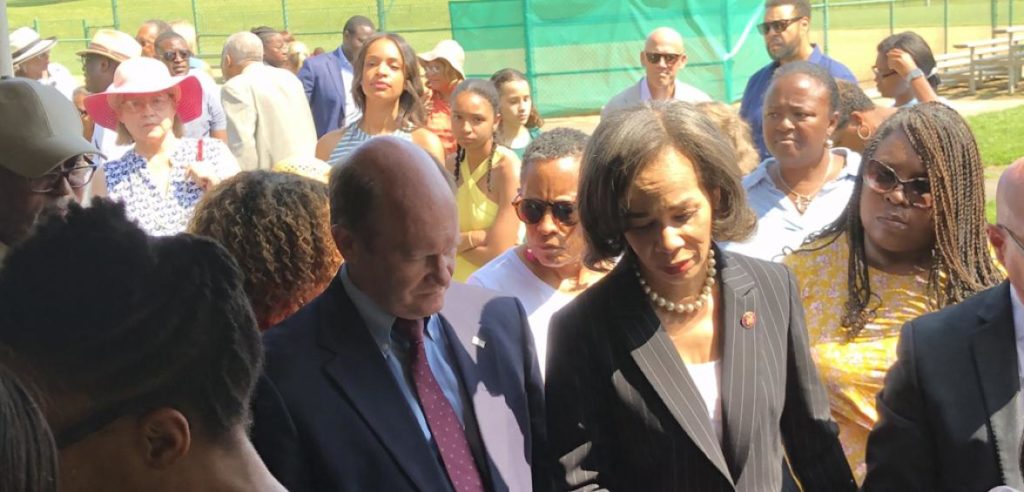Sunday, on the anniversary of the lynching death of George White, Delaware Senator Chris Coons, U.S. Representative Lisa Rochester, and the Delaware Legislative Black Caucus joined hundreds of community members to unveil a historical marker dedicated to remembering lynching in Delaware.
Savannah Shepherd, a junior at Sanford High School in Middleton, began investigating lynchings in her home state after attending the opening of EJI’s National Memorial for Peace and Justice in April 2018. When she discovered the lynching of George White in Odessa in 1903, she founded the Delaware Social Justice Remembrance Coalition to advocate for Delaware to acknowledge racial terror lynching by installing a historical marker at the site where George White was tortured and burned to death in 1903.
Ms. Shepherd provided evidence of the lynching and its legacy as part of her application to the Delaware Public Archives, which approved the marker. After the General Assembly approved it, State Senator Darius Brown funded the marker using his community transportation funds.
As part of the marker unveiling, Ms. Shepherd led community members in collecting soil from the site of the lynching. The soil will travel to the Milton Historical Society and then to Montgomery for inclusion in EJI’s exhibit of soil collected from lynching sites across the country.
“We need to be able to remember our history before we can begin to make our future better,” Ms. Shepherd told Delaware Public Radio. “We have a lot of work to do. But I think this marker will kind of bring everybody’s mind back to the past and realize that it’s not just the past … Because, yes, slavery was abolished, but we still see some forms of it in mass incarceration today.”
Savannah Shepherd with jar of soil collected from lynching site.
Bryan Stevenson’s sister, Christy Taylor (left), and brother, Dr. Howard Stevenson (right), with Savannah Shepherd (second from left) and EJI staff member Jonathan Kubakundimana (third from left), helped coordinate the event.
The Lynching of George White
On June 23, 1903, George White, a Black farm laborer, was lynched near Greenbank Park in Wilmington by a mob of white people. He was accused of murdering a white girl and taken to the New Castle County Workhouse to await trial. Mr. White denied having any involvement in the attack.
During this era, African Americans faced hostile suspicion and were often presumed guilty of violent crimes. Allegations of attempted violence against a white person by an African American person often sparked violent reprisal, regardless whether any evidence, fair investigation, or conviction supported the accusation.
The Delaware courts were in summer recess, and the presiding judges did not want to return from their vacations early. Public sentiments regarding Mr. White’s prosecution grew increasingly hostile, and within the week after Mr. White’s arrest, white mobs made two unsuccessful attempts to seize him from custody.
On June 21, Robert Elwood, a local white pastor held an outdoor evening service where he urged 3000 white residents to exact swift public vengeance. The next day, newspapers reported that a mob was forming, including participants from several neighboring communities and as far away as Pennsylvania and Maryland, and announced the times and locations of meetings where the lynching was being meticulously planned.
That evening, a mob of several hundred men and teenage boys stormed the jail. Local law enforcement refused the mob’s demand to hand over Mr. White and tried to repel the mob with high-pressure water hoses. Officers fired warning shots over the mob’s heads, and the mob returned fire. A white teenager was shot and fatally wounded, but the mob pressed on. Officers decided to prevent further damage to the jail and pointed the mob to Mr. White’s cell.
The mob took Mr. White to Price’s Corner, where they had built a pyre on which to burn him. It was reported that Mr. White tried to make a confession in order to save himself, but the mob was unmoved. They threw him onto the pyre and set it on fire in front of hundreds of spectators. As the flames engulfed Mr. White’s body and burned through his shackles, he attempted to escape at least three times. In his last attempt, someone used a hatchet to cut off his right foot, and someone else in the crowd struck him in the head with a fence post, and he fell back into the fire.
Mr. White died in the early morning hours of June 23. Members of the mob shot at his charred corpse. Pieces of Mr. White’s remains were taken as souvenirs by lynching spectators, including a local white physician who reportedly took Mr. White’s skull and right foot to display in the window of a local saloon.
Even though hundreds, if not thousands, of Wilmington residents were present for Mr. White’s lynching, no one responsible for his lynching was ever arrested or prosecuted. Robert Elwood was indicted by the Presbyterian denomination for six counts of “unchristian and unministerial conduct,” but ultimately received no more than a scolding to be more “judicious” in his sermons. He went on to become a nationally known figure and denied responsibility for Mr. White’s lynching throughout his career.
George White was one of more than 300 documented African American victims of racial terror lynching killed outside the Southern between 1877 and 1950. He is the only victim currently documented in Delaware. Mr. White’s lynching drew national attention and raised concern that lynching was moving beyond the South.
EJI’s Community Remembrance Project
EJI’s Community Remembrance Project is part of our campaign to recognize the victims of lynching by collecting soil from lynching sites, erecting historical markers, and developing the National Memorial for Peace and Justice, which acknowledges the horrors of racial injustice.
As part of its effort to help towns, cities, and states confront and recover from tragic histories of racial violence and terrorism, EJI is joining with communities to install historical markers in communities where the history of lynching is documented. EJI believes that by reckoning with the truth of the racial violence that has shaped our communities, community members can begin a necessary conversation that advances healing and reconciliation.
Lynching in America
Thousands of Black people were the victims of lynching and racial violence in the United States between 1877 and 1950. The lynching of African Americans during this era was a form of racial terrorism intended to intimidate Black people and enforce racial hierarchy and segregation.
Lynching was most prevalent in the South, including Alabama, Arkansas, Florida, Georgia, Kentucky, Louisiana, Mississippi, North Carolina, South Carolina, Tennessee, Texas, and Virginia. After the Civil War, violent resistance to equal rights for African Americans and an ideology of white supremacy led to violent abuse of racial minorities and decades of political, social, and economic exploitation.
In an expanded edition of Lynching in America, EJI also documented racial terrorism beyond Southern borders, detailing more than 300 lynchings of Black people in eight states with high lynching rates in the Midwest and the Upper South, including Oklahoma, Missouri, Illinois, West Virginia, Maryland, Kansas, Indiana, and Ohio.
Lynching became the most public and notorious form of terror and subordination. White mobs were usually permitted to engage in racial terror and brutal violence with impunity. Many Black people were pulled out of jails or given over to mobs by law enforcement officials who were legally required to protect them. Terror lynchings often included burning and mutilation, sometimes in front of crowds numbering in the thousands.
In response to this racial terror and violence, millions of Black people fled the South and could never return, which deepened the anguish and pain of lynching. Many of the names of lynching victims were not recorded and will never be known.

/
State Senator Darius Brown and Savannah Shepherd unveil marker.

/
Hundreds of people gathered for the unveiling ceremony.

/
Delaware Senator Chris Coons and U.S. Representative Lisa Rochester took part in a soil collection.